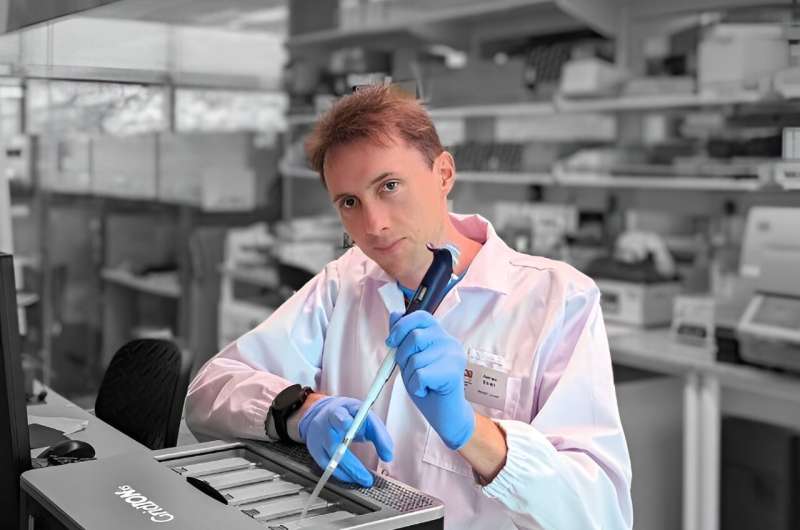Dr James Strutt, Senior Postdoctoral Associate at SMART CAMP, operating the Oxford Nanopore GridION long read sequencer. Credit: SMART
Researchers from Critical Analytics for Manufacturing Personalized-Medicine (CAMP) Interdisciplinary Research Group (IRG) at Singapore-MIT Alliance for Research and Technology (SMART), MIT's research enterprise in Singapore, in collaboration with Singapore Centre for Environmental Life Sciences Engineering (SCELSE) and Massachusetts Institute of Technology (MIT), have developed a novel method capable of identifying contaminants in T-cell cultures within 24 hours.
This method, adept at detecting low-abundance levels of microbial contaminants while effectively determining their types, ensures that therapeutic products like T-cell therapies are safe from contamination, with a faster turnaround—reducing the risk for patients and speeding up the process of getting these treatments to those in need.
The team's study is published in the journal Microbiology Spectrum.
Cell therapies are increasingly prevalent in the treatment of incurable diseases. For example, chimeric antigen receptor T-cells (CAR-T) are used for the treatment of blood-related cancers. Because these living medicines cannot be sterilized, assuring that cell therapy products are safe from microbial contamination before administering them for use in patients is of paramount importance.
Current traditional sterility tests help to guarantee microbial safety by ensuring that medical treatments are free from harmful contaminants. They improve the safety and efficiency of cell therapy manufacturing, playing an essential role in reducing the risk of treatments for patients. These traditional sterility methods are laborious and take between seven to 14 days; hence, faster methods could potentially be lifesaving for patients who cannot afford delays in their treatment. SMART CAMP's breakthrough method could enhance both the safety and efficiency of cell therapy manufacturing, resulting in improved patient outcomes and a more streamlined production process.
In their paper, SMART researchers detailed a novel method to detect contaminants in T-cell cultures within 24 hours, significantly faster than traditional methods that can take 7-14 days. The researchers employed cutting-edge technology like third-generation nanopore long-read sequencing and DNA extraction alongside machine learning algorithms to improve the overall process and ensure accuracy and speed. The primary objective is to differentiate between clean and contaminated samples and pinpoint the organisms most likely causing the contamination.
SMART's novel method utilizes third-generation nanopore long-read sequencing methodology to identify harmful microorganisms, followed by an advanced machine learning algorithm, computational analysis and optimization. Through this process, the researchers successfully identified the presence and types of microbial contaminants even at low abundance levels while also achieving this more quickly than standard compendial tests.
"The practical application of this discovery is vast; it offers faster product validation for biopharmaceutical manufacturers, reducing downtime and potentially accelerating product-to-market timelines. These advancements hold significant promise for the biopharmaceutical industry, as they not only enhance quality control but also improve overall efficiency and cost-effectiveness, ultimately benefiting patients by ensuring the safety and reliability of cell therapy products," said Dr. James Strutt, Senior Postdoctoral Associate at SMART CAMP and first author of the paper.
The research was presented by Dr. James Strutt at the A*STAR Mini Symposium in the Advances in Cell and Gene Therapy (A*CGT) in Singapore, and at the 31st Annual Intelligent Systems For Molecular Biology and the 22nd Annual European Conference on Computational Biology held in Lyon, France.
SMART CAMP is preparing to initiate testing to evaluate the integration of the novel T-cell sterility test into their processes and to further enhance the accuracy of contamination detection, while future research will focus on providing a similar level of detection for viruses and is currently being finalized at MIT. This advancement aims to provide more robust and dependable sterility assessments, in line with the SMART researchers' core goal of swiftly and accurately identifying sample contamination.
"Our rapid method offers a more efficient way to not only detect microbial contamination, but identify the contaminating species. We demonstrated that this method can deliver a high-sensitivity microbial sterility assessment within just 24 hours, providing a valuable tool for researchers and hopefully practitioners in the near future," added co-corresponding author Dr. Stacy L. Springs, Principal Investigator at SMART CAMP and Executive Director at MIT Center for Biomedical Innovation.
More information: James P. B. Strutt et al, Machine learning-based detection of adventitious microbes in T-cell therapy cultures using long-read sequencing, Microbiology Spectrum (2023). DOI: 10.1128/spectrum.01350-23
Provided by Singapore-MIT Alliance for Research and Technology (SMART)
























